Visuality of the Invisible: The Image of Medjed in Sources of the 21st Dynasty
Abstract
1. Introduction
- −
- Translation and commentary on a text connected with Medjed—a passage in the Book of the Dead Spell 17, together with analysis of this “deity’s” name;
- −
- Collection and analysis of existing interpretations of the iconography of Medjed;
- −
- Collect all available sources with the image of Medjded in Book of the Dead manuscripts and in coffins;
- −
- Discussion and proposed interpretation of the semantics of images of Medjed.
1.1. Medjed in Spell 17 of the Book of the Dead
 | |
| (71) rḫ.kwj rn n Mḏd pwy jmy⸗zn n pr Wsjr stj m jrt(⸗f) nn mꜢ.n.tw⸗f dbn (72) pt m nzrt n rꜢ⸗f smj ḥꜤpy ⟨nn⟩ mꜢ.n.tw⸗f | (71) I know the name of this Medjed who is with them in the House of Osiris, who shoots with (his) eye4 while he cannot be seen, who encircles the (72) sky with the flame of his mouth, who announces the Inundation while he <cannot> be seen. |
1.2. The Name ‘Medjed’
 ;
;  Mḏd (after Leitz (2002, III, p. 476) and Table 1) derives from the verb
Mḏd (after Leitz (2002, III, p. 476) and Table 1) derives from the verb  ,
,  mḏd, which according to Rainer Hannig bore up to seven meanings in different grammar constructions in the Middle Kingdom (Hannig 1995, p. 383; 2006, II, pp. 1173–74; cf. Erman and Grapow 1955, II, p. 191)5. Five of them are:
mḏd, which according to Rainer Hannig bore up to seven meanings in different grammar constructions in the Middle Kingdom (Hannig 1995, p. 383; 2006, II, pp. 1173–74; cf. Erman and Grapow 1955, II, p. 191)5. Five of them are:
- “to press”, “to squeeze a press” (“pressen”, “drücken”);
- “to get”, “to strike” (“treffen”);
- “to impose”, “to assign” (collecting a tax, etc.) (“auferlegen”);
- “to obey”, “to execute” (“gehorchen”, “befolgen”)”;
- “to divide” (“teilen”), etc.
 ,
,  , and
, and  ). The same
understanding is given by Stephen Quirke
(2013, p. 60): “one who presses”. T. George Allen and
Raymond Faulkner translated Mḏd as “Smiter” (Allen 1960, p. 90;
1974, pp. 30, 292; Faulkner 2001, p. 48). A quite
similar understanding “Chastiser” (“Каратeль”) was offered by Mikhail Chegodaev (2002, p. 100). Paul Barguet (1967, p. 62) gave the
translation “Broyeur” (i.e., “Breaker”/“Cruncher”), while Claude Carrier (2010, p. 18 (77))
translates “agitateur”. Erik Hornung (1979, p. 71) left the name of Mḏd untranslated: “Medjed” (see also
Cariddi 2018, pp. 203–4; Cariddi and Iannarilli 2020, pp. 83–84).
). The same
understanding is given by Stephen Quirke
(2013, p. 60): “one who presses”. T. George Allen and
Raymond Faulkner translated Mḏd as “Smiter” (Allen 1960, p. 90;
1974, pp. 30, 292; Faulkner 2001, p. 48). A quite
similar understanding “Chastiser” (“Каратeль”) was offered by Mikhail Chegodaev (2002, p. 100). Paul Barguet (1967, p. 62) gave the
translation “Broyeur” (i.e., “Breaker”/“Cruncher”), while Claude Carrier (2010, p. 18 (77))
translates “agitateur”. Erik Hornung (1979, p. 71) left the name of Mḏd untranslated: “Medjed” (see also
Cariddi 2018, pp. 203–4; Cariddi and Iannarilli 2020, pp. 83–84). ); that name later changed to Šsmw (Neugebauer and Parker 1960, pl. 27 (12. “crew” (?)); Leitz 2002, III, p. 476). It is noteworthy that both Medjed and Shesemu appear together in the same semantic context of Spell 17 of the Book of the Dead and are associated with the sky, light, and the inundation (Grapow 1917, (=Urk. V), Abs. 24, pp. 71–72 (61–62)). Bengt Peterson observed that this co-occurrence could confirm their connection (Peterson 1963; cf. Cariddi and Iannarilli 2020, pp. 79–83).
); that name later changed to Šsmw (Neugebauer and Parker 1960, pl. 27 (12. “crew” (?)); Leitz 2002, III, p. 476). It is noteworthy that both Medjed and Shesemu appear together in the same semantic context of Spell 17 of the Book of the Dead and are associated with the sky, light, and the inundation (Grapow 1917, (=Urk. V), Abs. 24, pp. 71–72 (61–62)). Bengt Peterson observed that this co-occurrence could confirm their connection (Peterson 1963; cf. Cariddi and Iannarilli 2020, pp. 79–83).2. Sources with Medjed Images: Catalogue
- 1.
- Papyrus of Ꜥnḫ⸗s-n-Mwt pCairo J.E. 95637/S.R. IV. 528 (unpublished)6 (Figure 1). This document represents a combination of the Book of the Dead and the content Amduat papyri (Books of the Netherworld). It contains the text of Spells 125A/125B and pictures originating from the vignettes of Spells 125B, 150, 83, 110, as well as four scenes (from left to right) from the central register of the vignettes in Spell 17: the image of a bnw-bird, goose, and falcon on a pedestal, and the three “demons”, the first with the head of a kite and the second with two opposite-facing falcon heads with mꜢꜤt-feathers. These demons hold knives. The last character is Medjed himself.
- 2.
- Papyrus of Ꜥnḫ⸗f-n-Ḫnsw pCairo J.E. 95658; S.R. IV. 5567 (Figure 2a,b). Six spells of the Book of the Dead are written in this roll: 1, 57, 89, 148, 56, and 9. Three spells (1, 148, and 9) are illustrated with coloured vignettes. Medjed is illustrated in Spell 148. The vignette shows the bꜢ-soul of the deceased before an offering table, behind which are six deities. The first three gods (from left to right) appear in the so-called Scene XIII of Spell 17 of the Book of the Dead (Milde 1991, pp. 36–37), while the last three figures represent “demons”, similar to those in the previous roll (no 1 above). Medjed is the last in this group.
- 3.
- Papyrus of TꜢ-bꜢk-n-Ḫnsw pCairo S.R. VII. 10222 (unpublished)8. The papyrus does not include any text of Spell 17 of the Book of the Dead, only its vignettes. The manuscript begins with a vignette of Spell 110 and is followed by Spells 149, 77, 89, 138, 148, 81A, and 1 with colour pictures. As was noted by Matthieu Heerma van Voss, the two spells in this roll are illustrated by vignettes of Spell 17—77 and 81A (Heerma van Voss 1977, pp. 87, 88). Spell 81A is accompanied by images of Isis and Nephthys in the form of kites near the mummy of Osiris, as well as figures of the god Heh and a falcon. All these images derive from the vignettes in Spell 17. The drawing of three “demons” together with Medjed (again in the final position), is presented as a vignette of Spell 77 of the Book of the Dead (Figure 3).
- 4.
- Papyrus of Jnj-pḥ⸗f-nḫt pCologny-Geneva C (Bibliotheca Bodmeriana, pBodmer 100)9 (von Bissing 1928, Taf. I; Sallé 1990, pp. 28–35; Bickel 2001, pp. 117–34, figs. 32, 39; Heerma van Voss 2008, pp. 163–66). In this document, as well as in all subsequent sources, Medjed appears in the context of the Spell 17 vignettes and text. This rather small papyrus (3.78 m) contains ten spells of the Book of the Dead, two of which are followed by coloured vignettes—Spells 17 and 125B. The scenes in Spell 17 are divided in five blocks, separated by the text columns. Only two of them (II and III) are published (von Bissing 1928, Taf. I; Bickel 2001, pp. 128–29, fig. 39; Tarasenko 2012, p. 383, fig. 4a–b; Cariddi 2018, p. 199, fig. 2b) (Figure 4a–c). In general, the sequence of scenes in the papyrus of Jnj-pḥ⸗f-nḫt has similarities with the Spell 17 vignettes in pBerlin P. 3157.
- 5.
- Papyrus of Nsy-tꜢ-nbt-jšrw pLondon BM EA 10554 (pGreenfield)10 (Budge 1912; Lenzo 2023). This roll belonged to the notable Theban priestess, the younger daughter of the High Priest of Amun Pinudjem II and his second wife Nsj-Ḫnsw (Niwiński 1988, pp. 226–30). This manuscript is probably the latest copy of the Third Intermediate Period Book of the Dead with the illustrations for Spell 17. In terms of chronology, it could therefore be the latest document with an image of Medjed11. This impressive roll of 40.53 metres is written in hieratic, as became common for the Book of the Dead during the late 21st Dynasty; the only spell written in hieroglyphs is 125B. The image of Medjed occurs twice in duplicated vignettes of Spell 17 accompanying other spells. In the first case, it illustrates Spells 23–26 (Budge 1912, pl. XV; Lenzo 2023, Sheet 12) (Figure 5a,b); the second example is with the part of the Hymn to Re and Osiris where a list of various “entities” or “forms” of Re is given (Budge 1912, pl. LXXXVIII; Lenzo 2023, Sheet 76) (Figure 5c,d).
- 6.
- Papyrus of Ꜥnḫ⸗f-n-Ḫnsw pCologny-Geneva CI (Bibliotheca Bodmeriana, pBodmer 101, unpublished)14. This is the first in a series of five almost identically “replicated” rolls that attest to a specific tradition of illustration that was confined to the 21st Dynasty (Tarasenko 2012, pp. 384–87). So far, only one roll of this group (pLondon BM EA 9948) has been partially published; the other four examples are practically unknown to scholars (cf. Niwiński 1989). These documents are of the greatest importance for reconstructing the stages of graphic development in papyri during this period, and they may constitute a special type (similar to the BD.II.1 type in the classification of Niwiński (1989, pp. 118–28)) playing an important role in this evolution (See in detail Tarasenko 2012, pp. 384–87). All these rolls have an identical order of spells and illustrations. They consist of an introductory vignette (individual in each document), the text of Spells 17 and 1 of the Book of the Dead, followed by a series of selected vignettes of Spell 17 (the top frieze). In total, a series of twelve scenes, starting with pictures of a cat, a serpent, and an jšd-tree,15 followed by the figures of Isis and Nephthys, and finishing with the adoration scene, are represented on these papyri. The images of three “demons”, with Medjed as the last of them, are in the eighth scene (‘h’) (Tarasenko 2012, p. 385). This scene is preserved in four rolls of this group. In the fifth document, the papyrus of Ḏd-Ḫnsw pSaint-Petersburg Hermitage 18587, it is destroyed16. Before these characters comes scene ‘g’, showing the adoration of Mekhet-Weret—similar to the papyrus of Jnj-pḥ⸗f-nḫt pCologny-Geneva C (Figure 4b)—and it is followed by the image of a deity in front of an offering table (scene ‘i’) (Tarasenko 2012, pp. 385–86) (Figure 6).
- 7.
- 8.
- 9.
- 10.
- The decoration of the interior walls of the lid of the inner coffin of PꜢ-dj-Ḫnsw Lyon Musée des Beaux-Arts H 2320–2321 (Jamen 2015, pp. 102–4) (Figure 10a,b).
3. Iconography of Medjed
 ) (Bruyère 1939, pp. 182–85; DuQuesne 2008, p. 19 (“a personification of a vessel for sacred oils”)). At the same time, DuQuesne (2008, p. 20) saw a possible connection between Medjed and the local shrine of Hathor at Asyut (See also DuQuesne 2002, pp. 39–60; Warkentin 2018, pp. 200–9). Cariddi (2018, pp. 203–4) suggests that the iconography may be based on a vessel with a sealed lid. She also cautiously observes a possible connection with the images of a fetish/symbol of the Thinite nome (TꜢ-wr, Gardiner’s sign R17:
) (Bruyère 1939, pp. 182–85; DuQuesne 2008, p. 19 (“a personification of a vessel for sacred oils”)). At the same time, DuQuesne (2008, p. 20) saw a possible connection between Medjed and the local shrine of Hathor at Asyut (See also DuQuesne 2002, pp. 39–60; Warkentin 2018, pp. 200–9). Cariddi (2018, pp. 203–4) suggests that the iconography may be based on a vessel with a sealed lid. She also cautiously observes a possible connection with the images of a fetish/symbol of the Thinite nome (TꜢ-wr, Gardiner’s sign R17:  (Gardiner 1957, p. 503)) or a mace-head.
(Gardiner 1957, p. 503)) or a mace-head.4. Discussion
5. Conclusions
Funding
Institutional Review Board Statement
Informed Consent Statement
Data Availability Statement
Acknowledgments
Conflicts of Interest
Appendix A
| No. | Document | BD 17 Vignette/Type by Cariddi (2018) | Type by Niwiński (1989) |
|---|---|---|---|
| 1 | Ꜥnḫ⸗s-n-Mwt pCairo J.E. 95637; S.R. IV. 528 Cursive Hieroglyphic Late 21st Dynasty Thebes Unpublished Bibliography: Niwiński (1989, p. 255 (pCairo 4)); Tarasenko (2012, p. 382 (5)); Cariddi and Iannarilli (2020, p. 85); Cariddi (2018, pp. 198, 200 (8)). | Polychrome Figure 2 M.3 | BD.III.1b + A.II.3 |
| 2 | Ꜥnḫ⸗f-n-Ḫnsw pCairo J.E. 95658/S.R. IV. 556 Cursive Hieroglyphic Late 21st Dynasty Thebes Unpublished Bibliography: Bruyère (1939, p. 184, fig. 78); Niwiński (1989, p. 260 (pCairo 19)); Tarasenko (2012, p. 382 (6)); Cariddi and Iannarilli (2020, p. 85); Cariddi (2018, p. 198 (7)). | Polychrome Figure 3 M.2 | BD.II.1 |
| 3 | TꜢ-bꜢk-n-Ḫnsw pCairo S.R. VII. 10222 Cursive Hieroglyphic Middle—late 21st Dynasty Thebes Unpublished Bibliography: Bruyère (1939, p. 183, fig. 77, 2); Niwiński (1989, p. 274 (pCairo 59)); Tarasenko (2012, p. 383 (2)); Cariddi and Iannarilli (2020, p. 85); Cariddi (2018, p. 198 (6)). | Polychrome Figure 4 M.3 | BD.II.1 |
| 4 | Jnj-pḥ⸗f-nḫt pCologny-Geneva C (Bibliotheca Bodmeriana) Cursive Hieroglyphic Middle 21st Dynasty Thebes Bibliography: von Bissing (1928), Taf. I; Niwiński (1989, p. 308 (pGeneva)); Sallé (1990, pp. 28–35); Bickel (2001, pp. 117–34, fig. 32, 39); Heerma van Voss (2008, pp. 163–66); Tarasenko (2012, pp. 383–84 (8)); Cariddi and Iannarilli (2020, p. 85); Cariddi (2018, p. 198 (4)). | Polychrome Figure 5b,c M.1 | BD.II.1 |
| 5 | Nsy-tꜢ-nbt-jšrw (Naville: Ec) pLondon BM EA 10554 (pGreenfield) Hieratic and Cursive Hieroglyphic Late 21st Dynasty—early 22nd Dynasty Thebes Bibliography: Budge (1912); Lenzo (2023); Niwiński (1989, p. 338 (pLondon 61)); Quirke (1993, pp. 50 (Nr. 145), 79 (fn. 145)); Rößler-Köhler (1999, pp. 95–98); Tarasenko (2012, pp. 381–82 (2)); Cariddi and Iannarilli (2020, p. 85); Cariddi (2018, p. 200 (9)). | Monochrome Figure 6 M.4 | BD.III.2 |
| 6 | Ꜥnḫ⸗f-n-Ḫnsw pCologny-Geneva CI (Bibliotheca Bodmeriana) Cursive Hieroglyphic 21st Dynasty Thebes Unpublished Bibliography: Valloggia (2001, p. 141); Tarasenko (2012, p. 384 (9)); Cariddi and Iannarilli (2020, p. 84); Cariddi (2018, p. 198 (1)). | Monochrome Figure 7 M.2 | − |
| 7 | TꜢ-nt-jmntt-hrt-jb pCologny-Geneva CII (Bibliotheca Bodmeriana) Cursive Hieroglyphic 21st Dynasty Thebes Unpublished Bibliography: Valloggia (2001, p. 142); Tarasenko (2012, p. 384 (10)); Cariddi and Iannarilli (2020, p. 85); Cariddi (2018, p. 198 (2)). | Monochrome Figure 8 M.2 | − |
| 8 | Nsy-Ḫnsw pTurin 1818 Cursive Hieroglyphic 21st Dynasty Unpublished Thebes Bibliography: Rößler-Köhler (1999, pp. 124–25); Tarasenko (2012, p. 384 (11)); Cariddi and Iannarilli (2020, p. 85); Cariddi (2018, p. 198 (3)). | Monochrome Figure 9b,c M.2 | − |
| 9 | Djw-sw-n-Mwt (var. Dmy-n-Mwt) pLondon BM EA 9948 Cursive Hieroglyphic Middle—late 21st Dynasty Thebes Bibliography: Shorter (1938); Niwiński (1989, p. 322 (pLondon 8)); Quirke (1993, pp. 35 (Nr. 45), 73 (fn. 45)); Rößler-Köhler (1999, pp. 123–24); Tarasenko (2012, pp. 384 (13); 385, fig. 5); Cariddi and Iannarilli (2020, p. 85); Cariddi (2018, p. 198 (5)). | Monochrome Figure 10b M.2 | BD.II.1 |
| 10 | PꜢ-dj-Ḫnsw Coffin Lyon Musée des Beaux-Arts H 2320–2321 (interior wall of the lid of the inner coffin) Cursive Hieroglyphic 21st Dynasty Thebes Bibliography: Jamen (2015); Tarasenko (2016, pp. 18–19, fig. 27a). | Monochrome Figure 11 M.2 | − |
| 1 | “Since the God is in everything and everything is in the God ‘who made millions of himself,’ there are practically no limits of the ways, in which He can be imagined, named or represented” (Niwiński 2000, p. 28). |
| 2 | “Only one imaginable or imaginary shape of God officially accepted by theologians” (Niwiński 2000, p. 28). |
| 3 | The database of Egyptian “demons” from the Middle and New Kingdoms was created by the Ancient Egyptian Demonology Project (https://voices.uchicago.edu/demonthings/demonbase/) (accessed on 29 June 2025), founded by Kasia Szpakowska (https://www.swansea.ac.uk/arts-and-humanities/arts-and-humanities-research/our-recent-research-projects/ancient-egyptian-demonology/) (accessed on 29 June 2025). |
| 4 | Chegodaev translates “who throws with his eyes” (“мечет глазами”) (Chegodaev 2002, p. 100), but in all New Kingdom examples of the spell the form “his eye” (jrt⸗f) is given in the singular (Lapp 2006, pp. 236–237). See Grapow (1917 (Urk. V) (Überschrift), pp. 26–27); Allen (1960, p. 90); Allen (1974, p. 30); Barguet (1967, p. 62); Hornung (1979, p. 71); Faulkner (2001, p. 48; LGG III, p. 476) (“der mit seinem Auge strahlt”); Quirke (2013, p. 60). |
| 5 | |
| 6 | Totenbuchprojekt Bonn, TM 134467, <totenbuch.awk.nrw.de/objekt/tm134467>. |
| 7 | Totenbuchprojekt Bonn, TM 134446, <totenbuch.awk.nrw.de/objekt/tm134446>. |
| 8 | Totenbuchprojekt Bonn, TM 134491, <totenbuch.awk.nrw.de/objekt/tm134491>. |
| 9 | Totenbuchprojekt Bonn, TM 134423, <totenbuch.awk.nrw.de/objekt/tm134423>. |
| 10 | Totenbuchprojekt Bonn, TM 134519, <totenbuch.awk.nrw.de/objekt/tm134519>. |
| 11 | Most likely, Nsy-tꜢ-nbt-jšrw died before the beginning of the Twenty-second Dynasty. |
| 12 | The image returns to a scene XVIII in Spell 17 of the Ramesside Book of the Dead (Milde 1991, p. 39), which shows a goose and a falcon flying above it. |
| 13 | I am thankful to John Baines for this observation. |
| 14 | Totenbuchprojekt Bonn, TM 134678, <totenbuch.awk.nrw.de/objekt/tm134678>. |
| 15 | |
| 16 | Nine fragments (one without a text) representing two parts of a introductory monochrome vignette were preserved (deceased in an adoration pose in front of the offering table, the figure of a deity did not remains); one fragment of a scene with a cat, a serpent, and jšd-tree, and Isis with Nephthys; one fragment of a scene with Khepry’s boat (only the vessel’s prow and one column of the text), and four fragments of the worshipping scenes. Besides, in the reconstruction of the roll in which the fragments were placed under glass, the introductory vignette was incorrectly located at the end of the roll, not at its beginning (on the right). |
| 17 | Totenbuchprojekt Bonn, TM 134677, <totenbuch.awk.nrw.de/objekt/tm134677>. |
| 18 | Totenbuchprojekt Bonn, TM 134600, <totenbuch.awk.nrw.de/objekt/tm134600>. |
| 19 | Totenbuchprojekt Bonn, TM 134536, <totenbuch.awk.nrw.de/objekt/tm134536>. |
| 20 | As Glenn Janes (Manchester) kindly noted to me, the sling above the eyes recalls seshed-headbands found on the Third Intermediate Period shabtis. |
| 21 | For symbolic and magical value of a belt see e.g., Baines (1975, pp. 1–24). |
| 22 | I am grateful to Dr Henk Milde (Leiden) for this comparison. |
References
- Allen, T. George. 1960. The Egyptian Book of the Dead. Documents in the Oriental Institute Museum at the University of Chicago. Oriental Institute Publications 82. Chicago: University of Chicago Press. [Google Scholar]
- Allen, T. George. 1974. The Book of the Dead or Going Forth by Day. Ideas of the Ancient Egyptians Concerning the Hereafter as Expressed in Their Own Terms. Studies in Ancient Oriental Civilization 37. Chicago: University of Chicago Press. [Google Scholar]
- Assmann, Jan. 1995. Egyptian Solar Religion in the New Kingdom: Re, Amun and the Crisis of Polytheism, 2nd rev. ed. London and New York: Kegan Paul International. [Google Scholar]
- Assmann, Jan. 2001. The Search for God in Ancient Egypt. Translated by David Lorton. Ithaca: Cornell University Press. [Google Scholar]
- Backes, Burkhard. 2005. Wortindex zum späten Totenbuch (pTurin 1791). Studien zum Altägyptischen Totenbuch 9. Wiesbaden: Harrassowitz Verlag. [Google Scholar]
- Baines, John. 1975. ‘Ankh-sign, belt and penis sheath. Studien zur Altägyptischen Kultur 3: 1–24. [Google Scholar]
- Barguet, Paul. 1967. Le Livre des Morts des anciens Égyptiens. Paris: Éditeur. Cerf. [Google Scholar]
- Bickel, Sussane. 2001. Entre angoisse et espoir: Le Livre des Morts. In “Sortir au jour”. Art égyptien de la Fondation Martin Bodmer. Catalogue. Edited by Jean-Luc Chappaz and Sandrine Vuilleumier. Cahiers de la Société d’Égyptologie 7. Genève: K. G. Saur, pp. 117–34. [Google Scholar]
- Bruyère, Bernard. 1939. Rapport sur les fouilles de Deir el Médineh (1934–1935). Fouilles de l’Institut Français d’Archéologie Orientale 16. Le Caire: L’Institut Français d’Archéologie Orientale. [Google Scholar]
- Budge, E. A. Wallis. 1912. The Greenfield Papyrus in the British Museum. The Funerary Papyrus of Princess Nesitanebtashru, Daughter of Painetchem II and Nesi-Khensu, and Priestess of Amen-Râ at Thebes, about B.C. 970. London: British Museum. [Google Scholar]
- Cariddi, Ilaria. 2018. Reinventing the afterlife: The curious figure of Medjed in the Book of the Dead. In Tradition and Transformation in Ancient Egypt: Proceedings of the Fifth International Congress for Young Egyptologists, Vienna, Austria, 15–19 September 2015. Edited by Andrea Kahlbacher and Elisa Priglinger. Vienna: Austrian Academy of Sciences, pp. 197–205. [Google Scholar]
- Cariddi, Ilaria, and Francesca Iannarilli. 2020. Di sangue e di vino: Analisi della correlazione tra le figure oltremondane Shezmu e Medjed. In Atti del XVIII Convegno di Egittologia e Papirologia: Siracusa, 20–23 Settembre 2018. Edited by Anna Di Natale and Corrado Basile. Siracusa: Istituto Internazionale del Papiro—Museo del Papiro “Corrado Basile”, pp. 77–93. [Google Scholar]
- Carrier, Claude. 2010. Série des Papyrus du Livre des Morts de l’Égypte ancienne. Volume I: Le Papyrus de Nouou (BM EA 10477). Melchat 3. Paris: Cybele. [Google Scholar]
- Chegodaev, Мikhail А. 2002. Izrecheniya “Knigi mertvych” (Spells of the “Book of the Dead”). In Istoriya Drevnego Vostoka: Teksty i documenty (The History of the Ancient Orient: Texts and Documents). Edited by Vasilyi I. Kuzischin. Moscow: “Vyshaya shkola”, pp. 95–110. (In Russian) [Google Scholar]
- Cromwell, Jennifer. 2022. From Pyramids to Obscure Gods: The Creation of an Egyptian World in Persona 5. Thersites 14: 1–40. [Google Scholar] [CrossRef]
- DuQuesne, Terence. 2002. Hathor of Medjed. Discussions in Egyptology 54: 39–60. [Google Scholar]
- DuQuesne, Terence. 2008. The Great Goddess and her companions in Middle Egypt: New findings on Hathor of Medjed and the local deities of Asyut. In Mythos und Ritual: Festschrift für Jan Assmann zum 70. Geburtstag. Edited by Benedikt Rothöhler and Alexander Manisali. Berlin: LIT-Verlag, pp. 1–26. [Google Scholar]
- Erman, Adolf, and Hermann Grapow. 1955. Wörterbuch der ägyptischen Sprache, 2nd ed. 5 vols. Berlin: Akademie Verlag. [Google Scholar]
- Faulkner, Raymond O. 2001. The Ancient Egyptian Book of the Dead, 3rd ed. Edited by Carol Andrews. Austin: University of Texas Press. [Google Scholar]
- Gardiner, Alan. 1957. Egyptian Grammar Being an Introduction to the Study of Hieroglyphs, 3rd rev. ed. Oxford: Oxford University Press. [Google Scholar]
- Grapow, Hermann. 1912. Das 17. Kapitel des Ägyptischen Totenbuches und Seine Religionsgeschichtliche Bedeutung. Inaugural-Dissertation zur Erlangung der Doktorwürde, Friedrich-Wilhelms-Universität zu Berlin, Berlin, Germany. [Google Scholar]
- Grapow, Hermann. 1917. Religiöse Urkunden Nebst Deutschen Vebersetzung. Ausgewählte Texte des Totenbuches. 2 vols. Leipzig: J.C. Hinrichs. [Google Scholar]
- Hannig, Rainer. 1995. Die Sprache der Pharaonen. Großes Handwörterbuch Ägyptische-Deutsch. Hannig–Lexica 1. Mainz am Rhein: Philipp von Zabern. [Google Scholar]
- Hannig, Rainer. 2006. Ägyptisches Wörterbuch II. Mittleres Reich und Zweite Zwischenzeit. 2 vols. Hannig Lexica 5. Mainz am Rhein: Philipp von Zabern. [Google Scholar]
- Heerma van Voss, Matthieu. 1977. Over het dateren van doadenboeken. Phoenix 23: 84–89. [Google Scholar]
- Heerma van Voss, Matthieu. 1988. Een Man en Zijn Boekrol: College Gegeven aan het Einde van zijn Ambtsperiode als Gewoon Hoogleraar aan de Universiteit van Amsterdam op Vrijdag 9 December 1988. Leiden: E.J. Brill. [Google Scholar]
- Heerma van Voss, Matthieu. 2008. Beginning and End in the Book of the Dead of the 21st Dynasty. In Egypt and Beyond. Essays Presented to Leonard H. Lesko upon his Retirement from the Wilbour Chair of Egyptology at Brown University June 2005. Edited by Stephen E. Thompson and Peter Der Manuelian. Providence: Brown University, pp. 163–66. [Google Scholar]
- Hornung, Erik. 1979. Das Totenbuch der Ägypter. Zürich: Artemis. [Google Scholar]
- Jamen, France. 2015. Le cercueil de Padikhonsou au musée des Beaux-Arts de Lyon (XXIe dynastie). Studien zum Altägyptischen Totentexten 20. Wiesbaden: Harrassowitz Verlag. [Google Scholar]
- Lapp, Günther. 2006. Totenbuch Spruch 17. Synoptische Textausgabe nach Quellen des Neuen Reiches. Totenbuchtexte 1. Basel: Orientverlag. [Google Scholar]
- Leitz, Christian, ed. 2002. Lexikon der ägyptischen Götter und Götterbezeichnungen. 8 vols. Orientalia Lovaniensia Analecta 111–116, 129. Leuven: Peeters. [Google Scholar]
- Lenzo, Giuseppina. 2023. The Greenfield Papyrus: Funerary Papyrus of a Priestess at Karnak Temple (c. 950 BCE). British Museum Publications on Egypt and Sudan 15. Leuven, Paris and Bristol: Peeters. [Google Scholar]
- Lesko, Leonard H. 2002. A Dictionary of Late Egyptian. 2 vols. Providence: BC Scribe Publications. [Google Scholar]
- Lucarelli, Rita, and Martin Andreas Stadler, eds. 2023. The Oxford Handbook of the Egyptian Book of the Dead. Oxford Handbooks. New York: Oxford University Press. [Google Scholar]
- Milde, Henk. 1991. The Vignettes in the Book of the Dead of Neferrenpet. Egyptologische Uitgaven 7. Leiden: Nederlands Instituut voor het Nabije Oosten. [Google Scholar]
- Munro, Irmtraut. 1988. Untersuchungen zu den Totenbuch-Papyri der 18. Dynastie. Kriterien ihren Datierung. London and New York: Kegan Paul Press. [Google Scholar]
- Neugebauer, Otto, and Richard A. Parker. 1960. Egyptian Astronomical Texts I: The Early Decans. Brown Egyptological Studies 3. Providence: Brown University Press. London: Lund Humphries. [Google Scholar]
- Niwiński, Andrzej. 1988. The Wifes of Pinudjem II—A Topic for Discussion. The Journal of Egyptian Archeology 74: 226–230. [Google Scholar] [CrossRef]
- Niwiński, Andrzej. 1989. Studies on the Illustrated Theban Funerary Papyri of the 11th and 10th Centuries B.C. Orbis Biblicus et Orientales 86. Frieburg and Göttingen: Universitätsverlag. Frieburg and Göttingen: Vandenhoeck & Ruprech. [Google Scholar]
- Niwiński, Andrzej. 2000. Iconography of the 21st dynasty: Its main features, levels of attestation, the media and their diffusion. In Images as Media: Sources for the Cultural History of the Near East and the Eastern Mediterranean (1st Millennium BCE). Edited by Christoph Uehlinger. Orbis Biblicus et Orientales, 175. Frieburg and Göttingen: Universitätsverlag, Frieburg and Göttingen: Vandenhoeck & Ruprech, pp. 21–44. [Google Scholar]
- Peterson, Bengt Julius. 1963. Der Gott Schesemu und das Wort Mḏd. Orientalia Suecana 12: 83–88. [Google Scholar]
- Quirke, Stephen. 1993. Owners of Funerary Papyri in the British Museum. British Museum Occasional Paper 92. London: British Museum Press. [Google Scholar]
- Quirke, Stephen. 2013. Going out in Daylight, prt m hrw, the Ancient Egyptian Book of the Dead. Translation, Sources, Meanings. GHP Egyptology 20. London: Golden House. [Google Scholar]
- Rößler-Köhler, Ursula. 1979. Kapitel 17 des Ägyptischen Totenbuches. Untersuchungen zur Textgeschichte und Funktionen eines Textes der Altägyptischen Totenliteratur. Göttinger Orientforschung IV, 10. Wiesbaden: Harrassowitz Verlag. [Google Scholar]
- Rößler-Köhler, Ursula. 1999. Zur Tradierungsgeschichte des Totenbuches der 17. und 22. Dynastie (Tb.17). Studien zum altägyptischen Totenbuch 3. Wiesbaden: Harrassowitz Verlag. [Google Scholar]
- Sallé, Alix. 1990. Le livre des Morts de l’Égypte ancienne. Archeologia 255: 28–35. [Google Scholar]
- Salvador, Rodrigo B. 2017. Medjed: From Ancient Egypt to Japanese Pop Culture. Journal of Geek Studies 4: 10–20. [Google Scholar]
- Shorter, Alan W. 1938. Catalogue of Egyptian Religious Papyri in British Museum. Copies of the Book PR(T)-M-HRW from the XVIIIth to the XXIInd Dynasty I: Representation of Papyri with Text. London: British Museum. [Google Scholar]
- Takács, Gábor. 2008. Etymological Dictionary of Egyptian. Volume Three: m–. Leiden: Brill. [Google Scholar]
- Tarasenko, Mykola. 2012. The vignettes of the Book of the Dead Chapter 17 during the Third Intermediate Period (21st–22nd Dynasties). Studien zur altägyptischen Kultur 41: 379–94, Taf. 35–37. [Google Scholar]
- Tarasenko, Mykola. 2014. The illustrations of the Book of the Dead Chapter 17 during the 18th Dynasty. In Doislams’kyy Blyz’kyy Skhid: Istoriya, Relihiya, Kul’tura [Pre-Islamic Near East: History, Religion, Culture]. Edited by Mykola Tarasenko. Kyiv: IS NANU, pp. 241–56. [Google Scholar]
- Tarasenko, Mykola. 2016. Studies on the Vignettes from Chapter 17 of the Book of the Dead I: The Image of mc.w BdSt in Ancient Egyptian Mythology. Archaeopress Egyptology 16. Oxford: Archaeopress. [Google Scholar]
- Tarasenko, Mykola. 2020. The vignettes of Chapter 17 from the Book of the Dead as found in the Papyrus of Nakht (London BM EA 10471): At the beginning of the Ramesside Iconographic Tradition. Journal of the Hellenic Institute of Egyptology 3: 131–46. [Google Scholar]
- Valloggia, Michel. 2001. Les manuscripts hiératiques et hiéroglyphiques de la Bibliotheca Bodmeriana. In “Sortir au jour”. Art égyptien de la Fondation Martin Bodmer. Catalogue. Edited by Jean-Luc Chappaz and Vuilleumier Sandrine. Cahiers de la Société d’Égyptologie 7. Genève: K. G. Saur, pp. 135–45. [Google Scholar]
- von Bissing, Friedrich Wilhelm. 1928. Totenpapyros eines Gottesvaters des Amon. Zeitschrift für ägyptische Sprache und Altertumskunde 63: 37–39. [Google Scholar] [CrossRef]
- Warkentin, Elizabeth Rose. 2018. Looking Beyond the Image: An Exploration of the Relationship between Political Power and the Cult Places of Hathor in New Kingdom Egypt. Ph.D. thesis, The University of Memphis, Memphis, TN, USA. [Google Scholar]


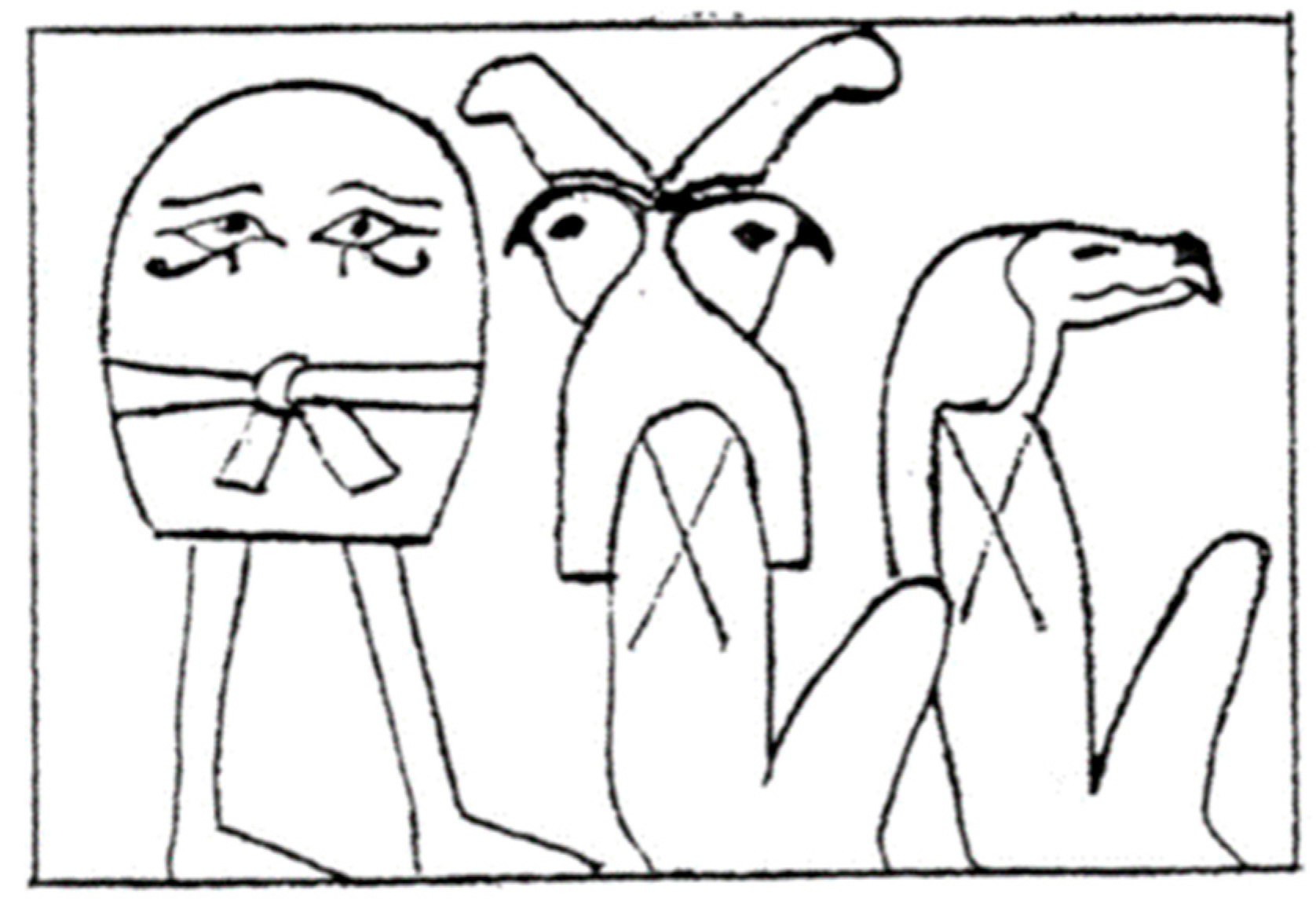
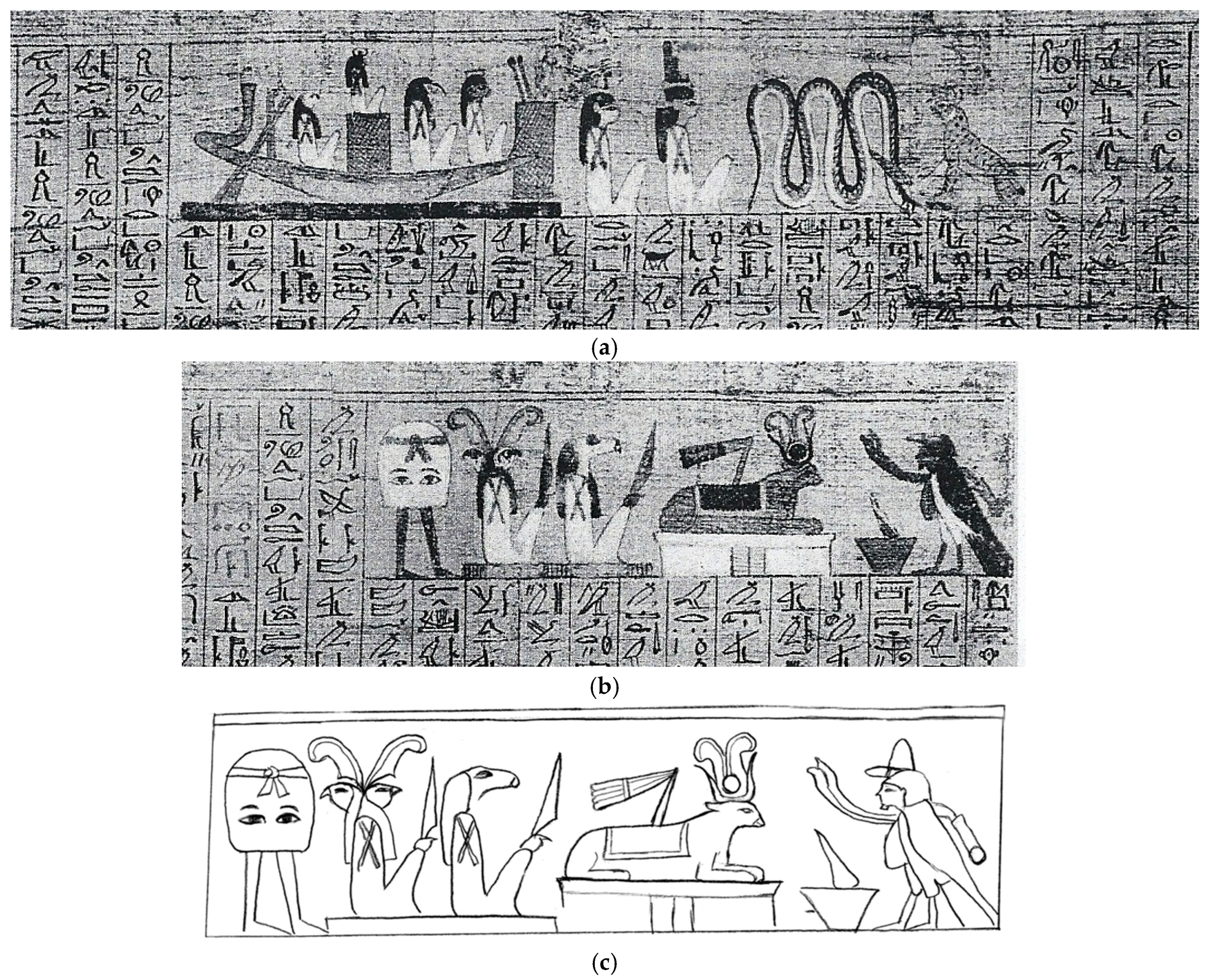



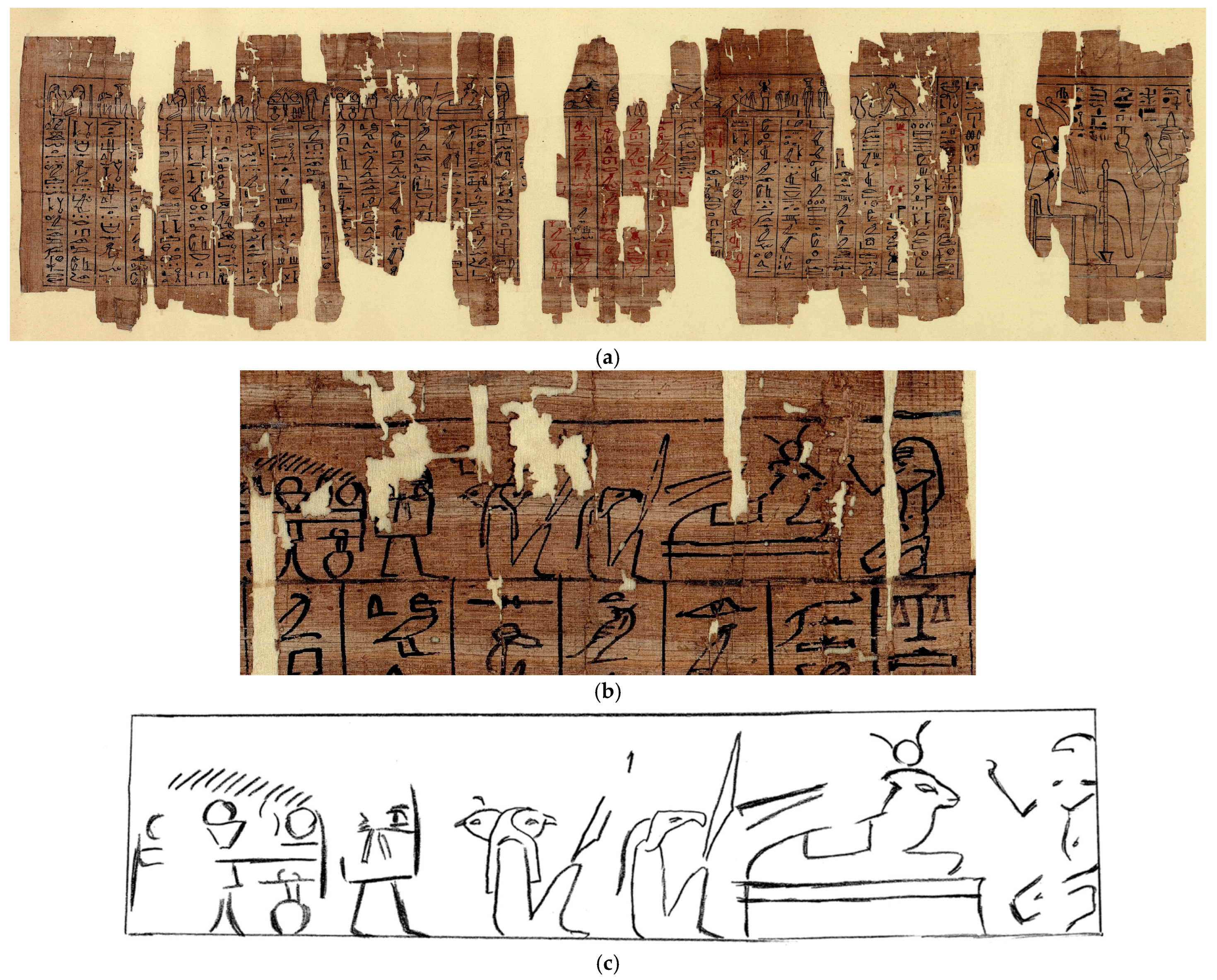
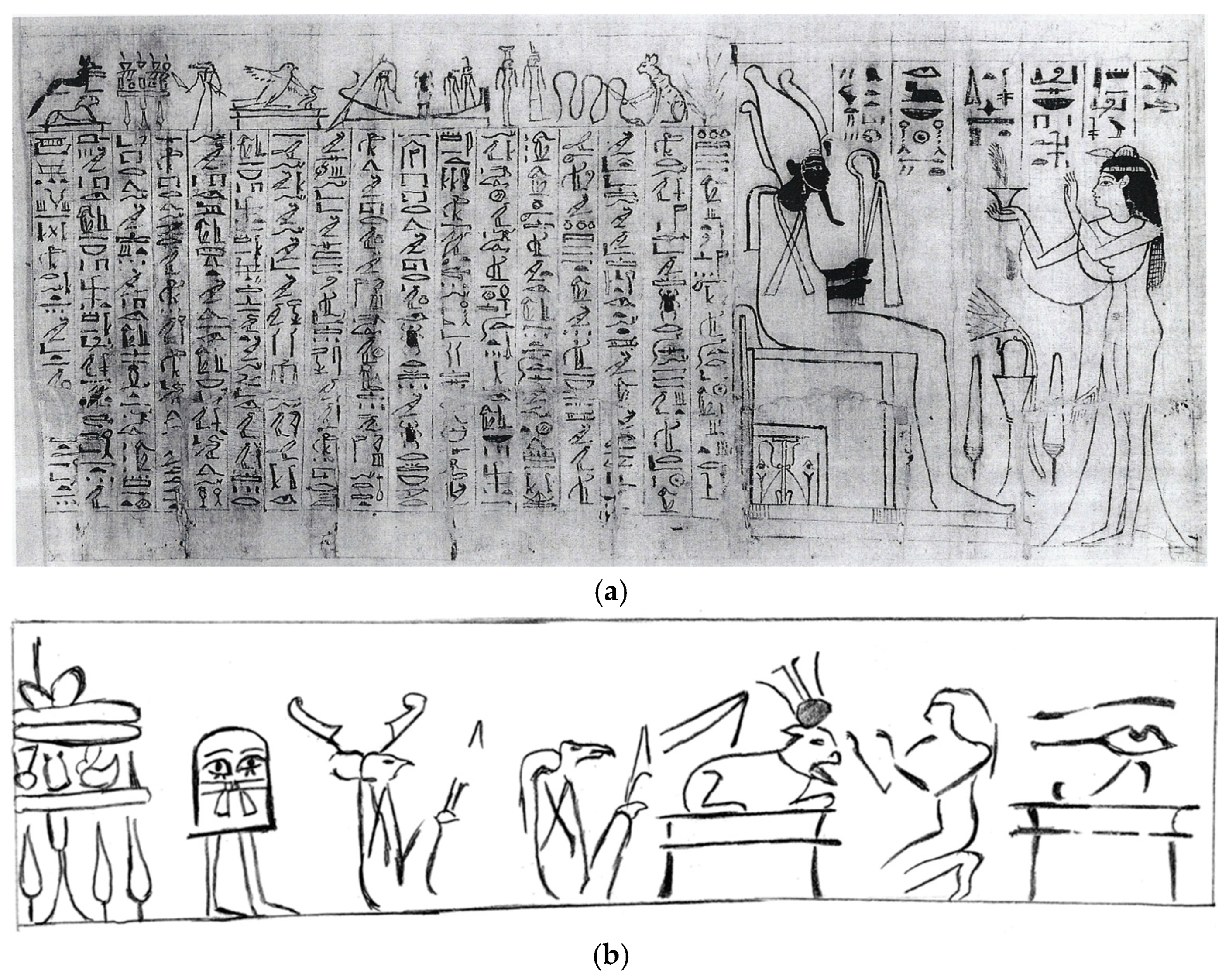

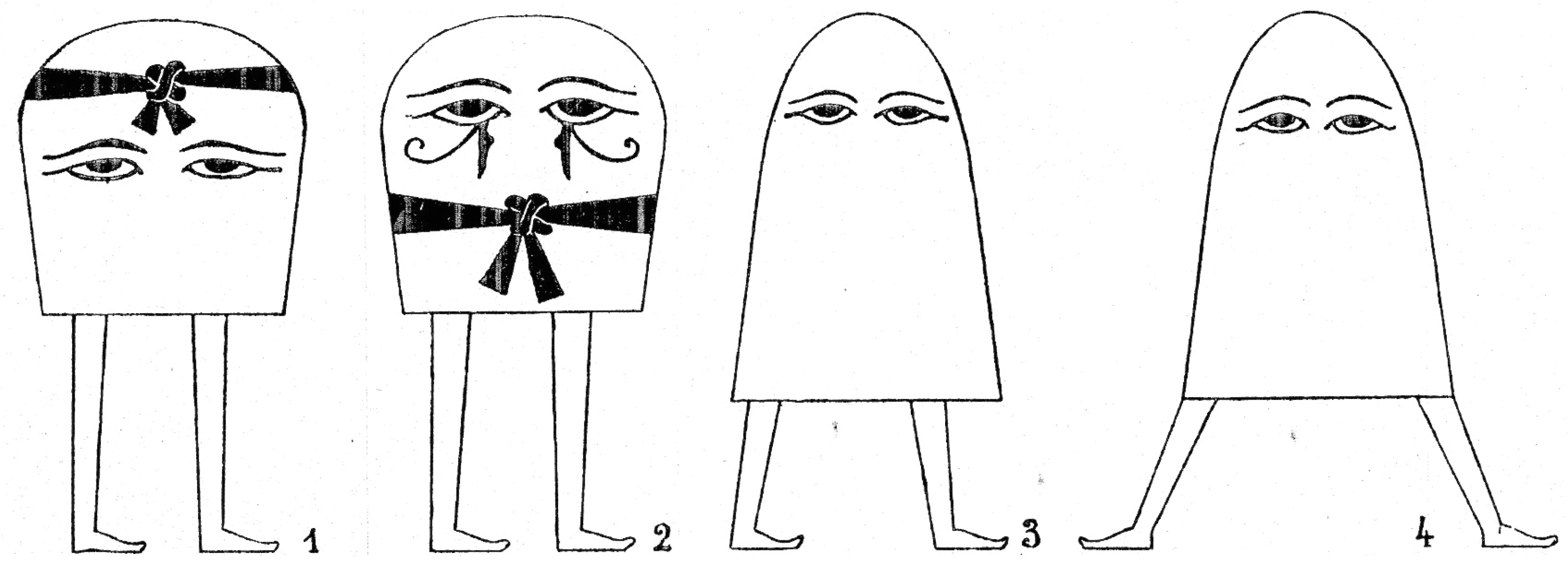
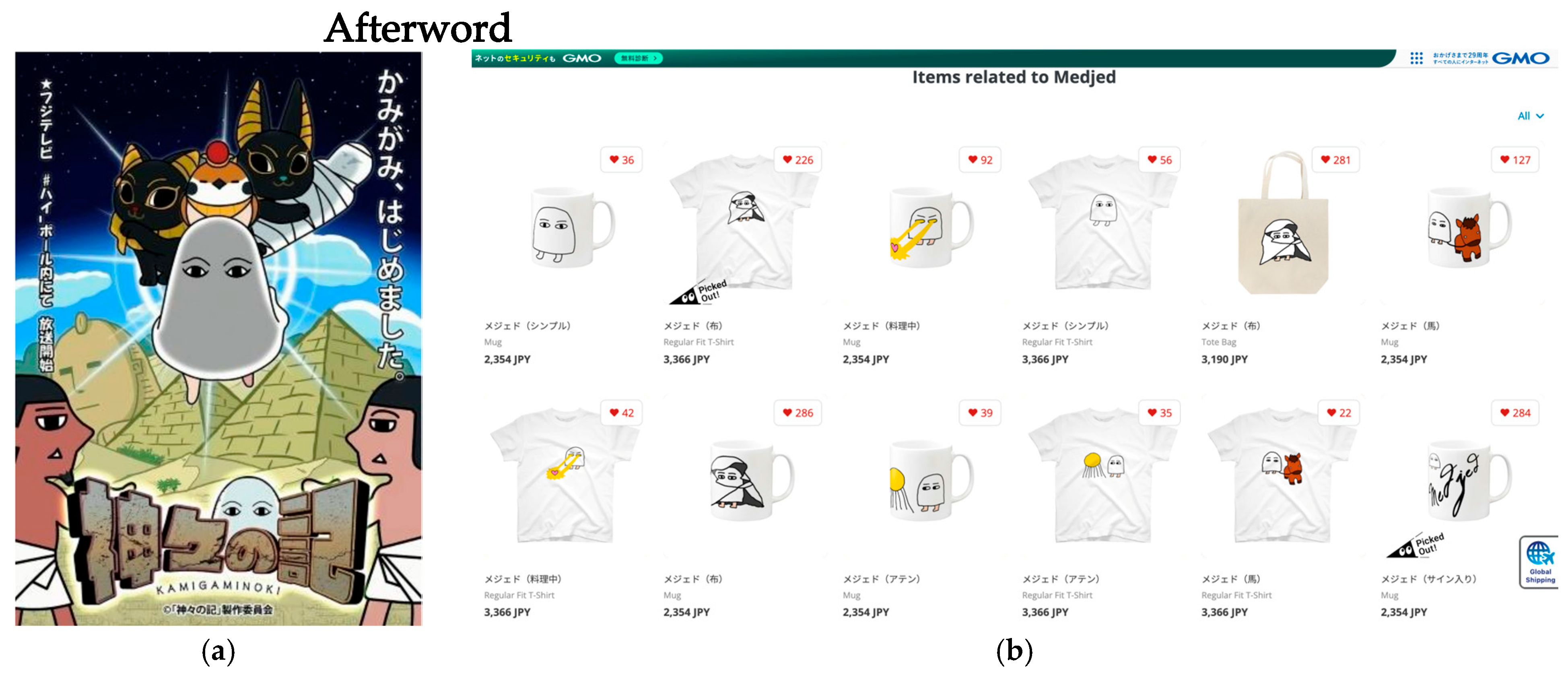
| pJwjꜢ pCairo CG 51189 (18th Dynasty) pNb.sny pLondon BM EA 9900 (18th Dynasty) pḪꜤ pTurin Suppl. 8438 (18th Dynasty) pNww pLondon BM EA 10477 (18th Dynasty) pJmn-m-jpt pVatican 38 600/1-2 (18th Dynasty) Tomb of Jmn-m-ḥꜢt TT 82 (18th Dynasty) | pJꜤḥ-ms pParis Louvre E. 11085 (18th Dynasty) pJmn-ḥtp pCairo CG 40002 (18th Dynasty) | pNfr-Mnw pLeiden T15 (19th Dynasty) | Shrine of Tutankhamun Cairo J.E. 60666 (18th Dynasty) |
 |  |  |  |
| Type | Description | Sources (Nos.) |
|---|---|---|
| M.1 | Medjed with a knotted red strip of cloth placed in the upper part of the demon’s body and human eyes painted below. The body has an ovoid shape and is coloured in white; the legs are filled in red. | 4 |
| M.2 | Medjed with the red ‘belt’ located in the middle of the body, under the eyes (drawn in the form of a wadjet eye); the shape of the body is a rough rectangle with a round top. | 2, 6, 7, 8, 9 |
| M.3 | Medjed has again wadjet eyes and the ‘belt’ in the lower part of the demon’s body, closer to the legs. | 1, 3 |
| M.4 | Medjed has human eyes, no ‘belt’, and a more elongated conical shape. | 5 |
Disclaimer/Publisher’s Note: The statements, opinions and data contained in all publications are solely those of the individual author(s) and contributor(s) and not of MDPI and/or the editor(s). MDPI and/or the editor(s) disclaim responsibility for any injury to people or property resulting from any ideas, methods, instructions or products referred to in the content. |
© 2025 by the author. Licensee MDPI, Basel, Switzerland. This article is an open access article distributed under the terms and conditions of the Creative Commons Attribution (CC BY) license (https://creativecommons.org/licenses/by/4.0/).
Share and Cite
Tarasenko, M. Visuality of the Invisible: The Image of Medjed in Sources of the 21st Dynasty. Arts 2025, 14, 87. https://doi.org/10.3390/arts14040087
Tarasenko M. Visuality of the Invisible: The Image of Medjed in Sources of the 21st Dynasty. Arts. 2025; 14(4):87. https://doi.org/10.3390/arts14040087
Chicago/Turabian StyleTarasenko, Mykola. 2025. "Visuality of the Invisible: The Image of Medjed in Sources of the 21st Dynasty" Arts 14, no. 4: 87. https://doi.org/10.3390/arts14040087
APA StyleTarasenko, M. (2025). Visuality of the Invisible: The Image of Medjed in Sources of the 21st Dynasty. Arts, 14(4), 87. https://doi.org/10.3390/arts14040087







